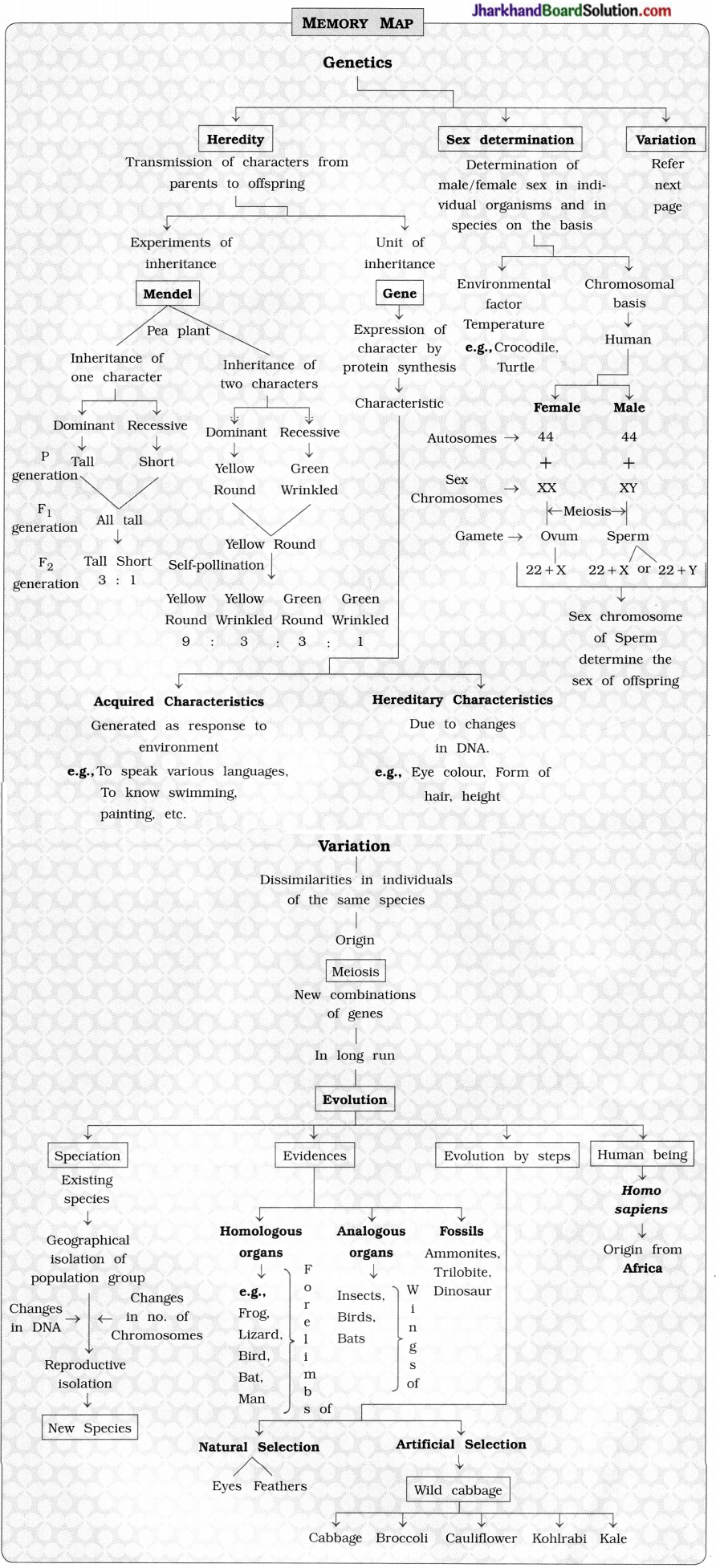Jharkhand Board JAC Class 10 Science Important Questions Chapter 9 Heredity and Evolution Important Questions and Answers.
JAC Board Class 10 Science Important Questions Chapter 9 Heredity and Evolution
Additional Questions and Answers
Question 1.
Distinguish between :
(1) Acquired characteristics and Hereditary characteristics
Answer:
| Acquired characteristics | Hereditary characteristics |
| 1. These develop as a reaction to the environment. | 1. These develop as a reaction to the changes in DNA. |
| 2. These changes occur in non-gametic somatic cells. | 2. These changes occur in the genes of gametes. |
| 3. These characteristics are not inherited in subsequent generations. | 3. These characteristics are inherited in subsequent generations. |
| 4. Scar of injury on face, the cutoff tail of a rat, expertise in certain games, etc. are the examples of acquired characteristics. | 4. Skin colour, form of hair on the scalp, appearance of jaws, eye colour, etc. are the examples of hereditary characteristics. |
(2) Dominant trait and Recessive trait
Answer:
| Dominant trait | Recessive trait |
| 1. The trait which is expressed in the F1 generation is called the dominant trait. | 1. The trait which is not expressed in the F1 generation is called the recessive trait. |
| 2. The dominant trait is expressed through its identical or different (contrasting) genes. | 2. The recessive trait is expressed in the absence of the dominant gene. |
| 3. The number of individuals having dominant trait is larger in F1 and F2 generations. | 3. The number of individuals having recessive trait are very few in F2 generation. |
| 4. The dominant gene can be expressed in presence of recessive gene. | 4. The recessive gene cannot be expressed in presence of dominant gene. |
![]()
(3) Homologous organs and Analogous organs
Answer:
| Homologous organs | Analogous organs |
| 1. The internal structure and fundamental origin of these organs are mostly similar. | 1. The fundamental structure and origin of these organs are totally dissimilar. |
| 2. Functionally these organs may be similar or dissimilar. | 2. Functionally these organs are always similar. |
| 3. The presence of these organs indicates common ancestors. | 3. The presence of these organs does not indicate common ancestors. |
| 4. The forelimbs of frog, lizard, bird and man are homologous organs. | 4. The wings of butterfly, wings of birds and those of bat are analogous organs. |
(4) Artificial selection and Natural selection
Answer:
| Artificial selection | Natural selection |
| 1. It is an artificial process used by man for breeding. | 1. It is a natural process of evolution. |
| 2. It is a controlled process for a limited period by the human beings. | 2. It is an on-going process for a continuous period by nature that affects all the global organisms. |
| 3. The selection of offsprings for improvement in their quality is beneficial for mankind. | 3. The characters selected for evolution are beneficial for the species because adaptation causes survival of species. |
| 4. The results of artificial selection are obtained in a short period. | 4. The results of natural selection are obtained after a very long period of time. |
Question 2.
Give scientific reasons for the following statements:
(1) Sexual reproduction gives rise to variations.
Answer:
Two parents are involved in sexual reproduction. The offspring inherits the genetic material (DNA) from both the parents through the gametes. Gametes are produced by meiosis. New combinations and new arrangement of genes are formed as a result of meiosis.
These new combinations of genes on the chromosomes generate one or more variations in the zygote that inherits into an offspring. Hence sexual reproduction creates more variations.
(2) The pea plants (Pisum sativum) were selected for Mendel’s experiments.
Answer:
- They are small plants and can be easily grown.
- They are annual plants. So there are more chances of studying more number of generations every year.
- It produces a large number of offsprings.
- Its flowers are bisexual and generally show self-fertilisation.
- Artificially cross pollination can be done as and when required.
- There are varieties of characters. Each character shows atleast two contrasting expressions.
(3) The characters are under the control of genes.
Answer:
A gene is the unit of heredity. It is a segment of DNA of specific length, arranged sequentially along the length of the chromosome.
Each gene is functionally specific and synthesizes a specific type of protein. The enzymes are all proteins and these proteins (as enzymes) induce specific biochemical process. The substances or proteins, formed during these processes, are responsible for the expression of characters. Hence, the characters are under the control of genes.
(4) The sex of the children is determined by father.
Answer:
The man produces two types of sperms. 50% of the sperms produced contain X as a sex chromosome, while the remaining 50% of the sperms contain Y as a sex chromosome. The woman produces all the ova of only one type, i. e., containing only one X-chromosome as a sex chromosome.
A child who inherits an X-chromosome from her father will be a girl and one who inherits a Y-chromosome from him will be a boy.
Thus, in human beings, the type of sperm that participates in the process of fertilisation, determines the sex of the child. Hence, the sex of the children is determined by father or by the paternal chromosomes in sperm.
(5) The chances of birth of a male child (son) or a female child (daughter) are equal.
Answer:
In human beings, the sex of the child is determined by the father. The father produces two types of sperms. Both the types of sperms are produced equally in number. 50% of the total sperms produced contain X-sex chromosome. While the remaining 50% of sperms produced contain Y-sex chromosome along with autosomes. The chances of each type of sperm to fertilise the ovum are therefore equal.
Hence, the chances of birth of a son or a daughter are equal.
![]()
(6) Sometimes in the earth’s crust the imprint of the entire body or the organs are maintained.
Answer:
The dead bodies of plants or animals, in presence of oxygen and moisture, undergo decomposition with the help of microorganisms. But sometimes in certain environmental conditions their bodies or organs do not get decomposed fully. The dead body may be entangled in mud and the same may be covered by dry stony covering. This prevents the dead body to decompose further. The mud settles around the dead body or organ in the shape of the later, and form stony covering. In this stony covering the imprint of the body or the organ is formed as a fossil.
That is why, sometimes in the earths crust the imprint of the dead body or the organs are maintained.
(7) It is not true that human beings have evolved from chimpanzees.
Answer:
Both human beings and chimpanzees had a common ancestor a long time ago. This common ancestor is likely to have been neither human or chimpanzee. The first step of separation from that ancestor is unlikely to have resulted in modern chimpanzees and human beings. Instead, the two resultant species have probably evolved in their own separate ways to give rise to the current forms.
That is why, it is not true that human beings have evolved from chimpanzees.
Question 3.
Carefully observe the given diagram / chart and answer the questions related with it:
(1) Form one pair of homologous organs and one pair of analogous organs from the diagrams given below:
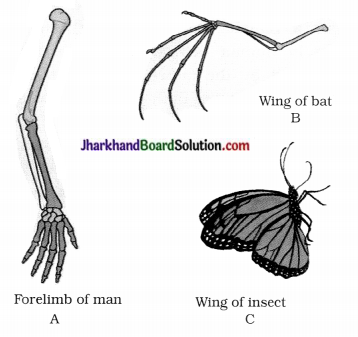
Answer:
Pair of homologous organs : A and B
Pair of analogous organs : B and C
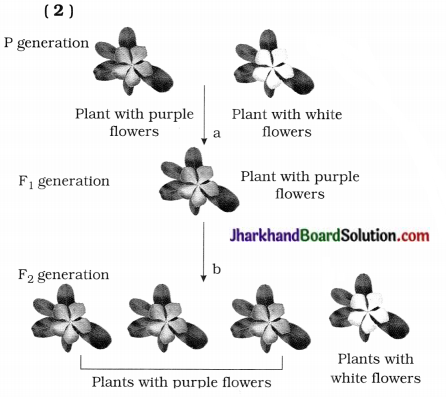
Questions :
- In the given figure state suitable word in place of a and b for the type of reproduction.
- Which character is a dominant one? How would you decide that it is a dominant character?
- What is the ratio of expression of dominant and recessive traits in the F2 generation?
Answer:
- a – Hybridisation, b – Self-fertilisation
- Purple colour of flowers is a dominant character and white colour is the recessive character. The hybridisation between the parents yield all plants having purple flowers in Fx generation which shows that it is dominant character.
- In F2 generation the ratio of expression of dominant character to the recessive character is 3:1.
(3) Identify the fossils a, b and c in the given diagrams:
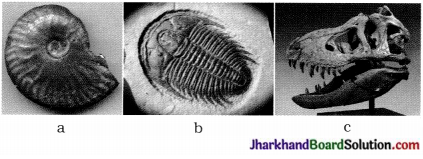
Answer:
- a-Ammonite (Invertebrate)
- b-Trilobite (Invertebrate)
- c-Skull of Dinosaur (Vertebrate)
(4) Mendel’s experiment to study inheritance in the pea plant (Pisum sativum) is shown in the following diagram. Study the diagram carefully and complete the empty boxes by filling them properly.
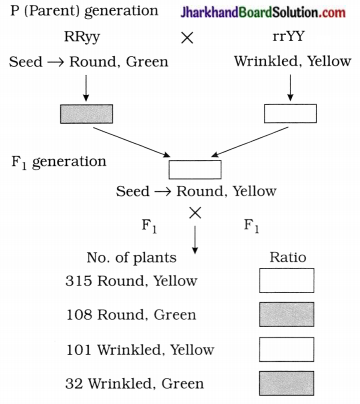
Answer:
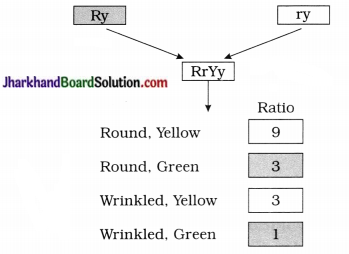
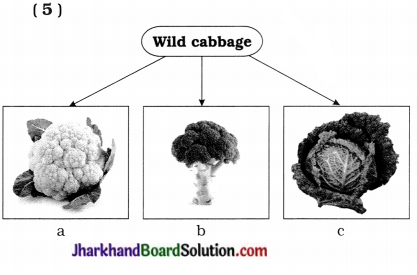
Name the diagrams a, b and c and from which part of the wild cabbage are they obtained? Which method is used for obtaining these?
Answer:
- a-Cauliflower – From the sterile flowers of wild cabbage.
- b- Broccoli -From the flowers in the wild cabbage, whose further development is arrested.
- c-Kale-Through the development of a few large leaves of wild cabbage.
Artificial selection is used for obtaining these.
(6) Fill in the missing details in the given chart:
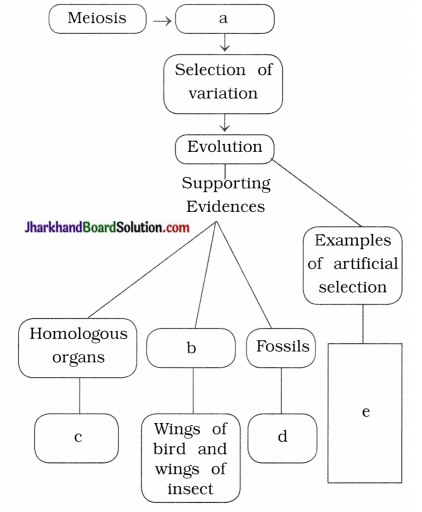
Answer:
- a – New combination (Recombination)
- b – Analogous organs
- c – Forelimb of human and birds
- d – Ammonite, Trilobite, Skull of Dinosaur
- e – Kale, Broccoli, Cauliflower, Red cabbage
Objective Questions and Answers
Question 1.
Answer the following questions in short:
(1) State the example of animal in which sex is not genetically determined.
Answer:
In snail, sex is not genetically determined.
(2) How you can say that some animals rely entirely on environmental cues for sex- determination?
Answer:
In a few reptiles, the temperature at which fertilised eggs are kept determines whether the animals developing in eggs will be male or female. By this we can say that some animals rely entirely on environmental cues for sex- determination.
(3) Name two organisms which are now extinct and are studied from their fossils.
Answer:
The extinct animals Archaeopteryx and Dinosaurs are studied from their fossils.
(4) Name five varieties of vegetables which have been produced from ‘wild cabbage’ by the process of artificial selection.
Answer:
Broccoli, cabbage, cauliflower, kohlrabi and kale are the varieties of vegetables, which have been produced from ‘wild cabbage’ by the process of artificial selection.
(5) Name the ancestor of the following:
Broccoli, Kohlrabi, Kale
Answer:
Wild cabbage
![]()
(6) Choose the one term from the following, which includes the other three:
Broccoli, wild cabbage, cauliflower, cabbage.
Answer:
Wild cabbage
(7) Whether pea plant is a self-pollinated plant or a cross pollinated one?
Answer:
Pea plant is a self-pollinated plant but artificially cross-pollination can be done.
(8) Give the name of the flatworm which was the first to possess the eyes. State in which form and what it detects.
Answer:
A flatworm named Planaria posseses very simple eyes. That are in form of eyespots which detect light.
(9) State the probability of birth of offspring as a son or a daughter.
Answer:
The probability of birth of offspring as a son or a daughter is 50%, i.e., 1:1.
(10) How do X and Y chromosomes differ?
Answer:
X is normal sized while Y is a short chromosome.
(11) Which character indicates that the birds are closely related to Dinosaurs?
Answer:
Feathers present in head region of fossilized specimens of Dinosaurs indicate that the birds are closely related to Dinosaurs.
(12) Which evidences in the field of biology are considered to be the ancient documents?
Answer:
Fossils evidences in the field of biology are considered to be the ancient documents.
(13) How do we know that extinct species ever existed?
Answer:
From fossils, we know that exinct species ever existed.
(14) For what purpose is the study of fossils important?
Answer:
The study of fossils important for to study of evolution of any species as well as the idea about the extinct species.
(15) Give an example of homologous and analogous organs using same animals.
Answer:
- Homologous organs → Bird arms and bat arms,
- Analogous organs → Wing of a bird and wing of a bat.
(16) Evidences from which types of organs do not suggest any common ancestory in the course of evolution?
Answer:
Evidences from analogous organs do not suggest any common ancestory in the course of evolution.
(17) Do all variations in a species have equal chances of surviving in the environment? Why?
Answer:
No, because depending on the nature of variations, different individuals would have different kinds of advantages.
(18) Who forms the basis for evolutionary processes?
Answer:
Selection of variants by environmental factors forms the basis for evolutionary processes.
(19) What is earlobe? Which are dominant and recessive variants respectively?
Answer:
The lowest part of the ear pinna is called earlobe. Amongst two variants, free earlobe is dominant and attached earlobe is recessive.
(20) According to Mendel’s experiment, the tall plants in F1 generation were exactly the same as the tall plants of the parent generation? Why?
Answer:
No, because plants in F1 generation were genetically Tt (heterozygous) whereas plants of parent generation were TT (Homozygous dominant).
(21) How do germ cells make a single set of genes from the normal two copies in all other cells of body?
Answer:
In meiosis, germ cells undergo reduction division forming a single set of genes from the normal two copies in all other cells of body.
(22) Can asexually reproducing organisms follow similar rules of inheritance? Why?
Answer:
No, because single parent is involved in it and normal two copies of genes are inherited of parent.
[In bacteria, few algae, fungi and bryophytes have only single set of genes in their normal body cells.]
(23) Do tailless mice have tailless progeny? Why or why not?
Answer:
No, because loss of tail cannot change the genes of the germ cells of the mice.
(24) Explain the word : Micro-evolution
Answer:
Micro-evolution means a small change in common characteristics of a group of organisms of a particular species. Microevolution is change in gene frequencies of populations. Slowly and gradually micro-evolution helps in the progressive change of population. Microevolution does not explain the process of speciation.
(25) What is called when two populations of a species cannot reproduce with each other?
Answer:
When two populations of a species cannot reproduce with each other, it is called reproductive isolation and two populations can be called two independent species.
(26) What is the meaning of characteristics?
Answer:
Characteristics are the details of appearance or behaviour of an organism showing a particular form or a particular function.
(27) What allows us to make classification groups?
Answer:
On the basis of similarities and fundamental differences among organisms, a hierarchy is developed that is used in making classification groups.
(28) When is it said that two species have a common ancestor?
Answer:
When the two species show more common characteristics, they are more closely related. Such two species show that they diverged recently. This indicates that they had a common ancestor.
(29) Which fossil was found in the Narmada Valley a few years ago?
Answer:
The dinosaur skull fossil was found in the Narmada Valley a few years ago.
(30) Which method is now extensively used for tracing evolutionary relationships?
Answer:
Estimation of the change in DNA during species formation and comparison of the DNA from different species is now extensively used for tracing evolutionary relationships.
(31) Which tools have been used for studying human evolution?
Answer:
The same tools for tracing evolutionary relationships – excavating, time-dating and study fossils, as well as determing DNA sequences have been used for studying human evolution.
(32) From where the genetic footprints of Homo sapiens can be traced?
Answer:
The genetic footprints of Homo sapiens can be traced back to our African roots.
Question 2.
Define : OR Explain the terms :
(1) Heredity
Answer:
Heredity: A process of transmission of characters generation after generation is called heredity. It is a process by which parental characters are transmitted to offsprings.
(2) Trait
Answer:
Trait: It is a distinguishing feature of a person’s character.
In simple term, trait is the way in which the characters of an organism are expressed.
Examples : Blond hair, blue eyes, attached earlobes, tallness, etc.
(3) Gene
Answer:
Gene : A section of DNA (nucleotide sequence) that provides information for the synthesis of a specific protein is called gene.
![]()
(4) Sex determination
Anwer:
Sex determination: The phenomenon of determining the sex of an individual of a species is called sex determination.
- There are different strategies e.g., temperature, chromosomes, genes, hormones, etc. responsible for determining the sex in certain animals.
- In certain animals, the sex determination is not genetically determined, e.g., the Snails can change their sex.
- In human beings in each cell there are 22 pairs of autosomes and 1 pair of sex chromosomes. The 23rd pair is either XX as in females or XY as in males.
(5) Genetic drift
Answer:
Genetic drift: A change in the frequency of some genes in a population which provides diversity without any survival advantage is called genetic drift.
(6) Speciation
Answer:
Speciation: The phenomenon of origin of a new species from the pre-existing one due to reproductive isolation of a part of its population is called speciation.
Speciation is caused due to genetic drift, natural selection, geographical and reproductive isolation.
(7) Evolution
Answer:
The gradual process by which complex and diverse life forms are created from simple form of organisms by different evolutionary forces over a long time is called evolution.
(8) Natural selection
Answer:
Environment selects the best variant organisms with better adaptation. New species are evolved from such highly adapted species after many generations is called natural selection.
Question 3.
Fill in the blanks :
- The variations generated during ………………… become hereditary.
- The geographical isolation along with the variations leads to the formation of …………………
- The classification of living organisms explain their ………………… relationships.
- Broccoli has been developed from ………………… by ………………… artificial selection.
- ………………… is called the science of heredity and variations.
- The idea of evolution of species by natural selection was given by …………………
- Selection of ………………… by environmental factors forms the basis for evolutionary processes.
- The synthesis of enzymes in the cell is under the control of …………………
- The growth of a pea plant depends on the amount of specific ………………… in the plant.
- The presence of Y-chromosome in human being is essential for being a …………………
- ………………… provides diversity without any adaptation.
- The ………………… characteristic comes into existence due to changes occurring in DNA.
- The eyes of ………………… are very simple and in the form of a dot.
- The Dinosaurs having feathers, belong to class …………………
- The existing mankind, present on the earth has originally descended from …………………
- The reduction of weight in the beetle due to starvation is ………………… trait.
Answer:
- sexual reproduction
- species
- evolutionary
- wild cabbage
- Genetics
- Charles Darwin
- variants
- genes
- hormones
- male
- Genetic drift
- hereditary
- Planaria
- Reptilia
- Africa
- acquired
Question 4.
State whether the following statements are true or false :
- Asexual reproduction generates a large s proportion of variations.
- In asexual reproduction, variations arise due to the changes occurring during DNA copying.
- The garden pea plants of Pisum sativum selected by Mendel were having long life cycle s and could be reared with lots of difficulties.
- In Mendel’s experiments, characters of both the parents were observed in F1 generation.
- Both the types of pea plants, used as parent generation by Mendel in his experiments, were pure breeds in the expression of their characters.
- Gene is a definite segment of DNA, which possesses information for the synthesis of a specific type of protein.
- In human being, the son obtains one X-chromosome from each of the two parents, the mother and the father.
- The sex determination in human being occurs right at the time when the fertilisation occurs therein.
- In Dinosaurs, the feathers provided insulation in cold weather.
- The internal structure and arrangement of bones of the forelimbs of frog, lizard, bird, bat and man are different.
- The wings of birds and those of insects are homologous orgAnswer:
- In the experiment performed by Mendel on dihybrid inheritance, there are four types of plants formed in the Fx generation.
- All human races are a single species.
- Since the life originated on the earth, the evolution is a continuous, non-stop process.
- Two different species originated from a common ancestor can mutually reproduce amongst themselves.
Answer:
- False
- True
- False
- False
- True
- True
- False
- True
- True
- False
- False
- True
- True
- True
- False
Question 5.
Graph-diagram based questions :
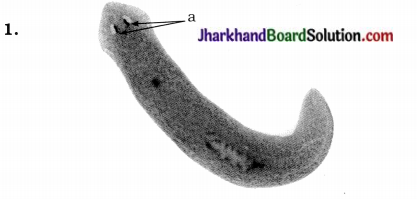
Identify the organism and label ‘a’ with its function.
Answer:
Flatworm (Planaria)
a – simple eyes as eyespots. It detects light.
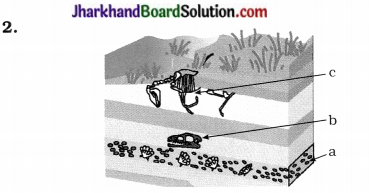
Identify the fossils in successive layer a, and c.
Answer:
a – invertebrate fossils
b – skull of dinosaur
c – horse-like fossils
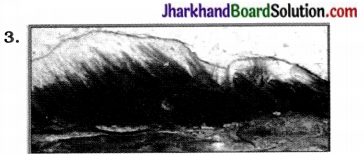
What is your conclusion from this diagram?
Answer:
Conclusion : The dinosaur could not fly and s it is possible, that the evolution of feathers had nothing to do with flight. But during evolution reptiles may have given rise to birds.
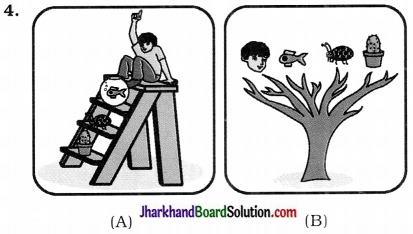
Which diagram is correctly explained how does evolution proceed? Why?
Answer:
Diagram B, i.e., multiple branches of family tree of species. Because evolution does not proceed stepwise like a staircase but it is like the branches of tree.
Example : Chimpanzee and human beings have probably evolved in their own separate ways to give rise to the two species from a common ancestor long-time ago.

From the diagram, state the result in case I, II and III.
Answer:
I. It is a case of natural selection of green beetle population.
II. It is a case of genetic drift which provides diversity without any adaptations.
III. It is a case of acquired trait of low weight beetles due to starvation.
Question 6.
Match the following:
(1)
| Column I | Column II |
| 1. Gene | p. Genetical trait |
| 2. New combination | q. Segment of DNA |
| 3. Y-chromosome | r. Meiosis |
| 4. Inheritance | s. Male sex |
Answer:
(1 – q), (2 -r ), (3 – s), (4 – p).
(2)
| Column I | Column II |
| 1. Snail | p. Reptilia |
| 2. Dinosaurs possessing feathers | q. Eye-spots for the first time |
| 3. Ammonites | r. Can change sex |
| 4. Planaria | s. Fossils |
Answer:
(1 – q), (2 – r), (3 – s), (4 – p).
![]()
(3)
| Column I | Column II |
| 1. Variation | p. Change in variety by selective hybridisation |
| 2. Natural selection | q. Change in form or function of the organism |
| 3. Artificial selection | r. Ratios of isotopes |
| 4. Dating fossils | s. Evolution of species |
Answer:
(1 – q), (2 – s), (3 – p), (4 – r).
(4)
| Column I (Characters in pea plant) | Column II (Dominant) | Column III (Recessive) |
| 1. Seed | p. Yellow | a. Short |
| 2. Seedcoat | q. Tall | b. White |
| 3. Flower | r. Axial | c. Shrunk |
| 4. Height | s. Round | d. Apical |
| t. Purple | e. Green | |
| u. Oblong | f. Wrinkled |
Answer:
(1 – s – f), (2 – p – e), (3 – t – b), (4 – q – a).
(5)
| Column I | Column II |
| 1. Trilobite | p. Analogous organs |
| 2. Knightia | q. Homologous organs |
| 3. Arms of bird and bat | r. Fossil-fish |
| 4. Wing of a bird and a bat | s. Fossil – invertebrate |
Answer:
(1 – s), (2 – r), (3 – q), (4 – p).
Question 7.
Select the correct alternative from those given below each question:
1. In which of the following, the new combinations of genes formed?
A. Vegetative reproduction
B. Asexual reproduction
C. Sexual reproduction
D. Budding
Answer:
C. Sexual reproduction
2. When hybridisation is carried out between a tall (TT) pea plant and a short (tt) pea plant, all the plants (offsprings) show the expression of tallness, because…
A. the expression of tallness is dominant.
B. the expression of short is dominant.
C. the expression of tallness is recessive.
D. the character of tallness in pea plant is not controlled by gene T or t.
Answer:
A. the expression of tallness is dominant.
3. Study following statements (P to R) and choose the correct alternative :
P: Those organs which have the same internal structure but different functions are called homologous orgAnswer:
Q: Organs which have different basic design but have similar appearance and carry out similar functions are called analogous orgAnswer:
R: The impressions of dead plants or animals that lived in the past are known as fossils.
A. Only R is true.
B. All the three statements are true.
C. Statements P and Q are true, but R is false.
D. All the three statements are false.
Answer:
B. All the three statements are true.
4. Which is a false statement for variation?
A. All the variations in a species provide equal opportunity for survival.
B. Very few variations are generated in asexual reproduction.
C. Variations selected by the environmental factors cause the occurrence of evolution.
D. The change in the genetic material (DNA) results in variation.
Answer:
A. All the variations in a species provide equal opportunity for survival.
5. What do the examples of Dinosaurs having feathers and the birds having feathers suggest in the study of evolution?
A. The reptiles have been evolved from Aves.
B. The Aves have been evolved from reptiles.
C. Both are the animals of the same class.
D. There is no evolutionary relationship between these two groups of animals.
Answer:
B. The Aves have been evolved from reptiles.
6. Which scientist was the first to conduct systematic experiments for the study of heredity?
A. Watson
B. Sutton
C. Mendel
D. Khorana
Answer:
C. Mendel
7. Which factor conducts the expressive genetic information from one generation to another?
A. Protein
B. DNA
C. RNA
D. Enzyme
Answer:
B. DNA
8. Which one of the following is not homologous?
A. Forelimbs in humans and lizard
B. Forelimbs in lizard and frog
C. Wings of butterfly and bat
D. Wings in bat and bird
Answer:
C. Wings of butterfly and bat
9. Which type of animals were the Dinosaurs having feathers?
A. Reptilia
B. Aves
C. Mammalia
D. Both A and B
Answer:
A. Reptilia
10. Which plant was obtained, from the sterile flowers of cabbage, by using the artificial selection technique?
A. Broccoli
B. Cauliflower
C. Kohlrabi
D. Kale
Answer:
B. Cauliflower
11. With which region are the genetical footprints of the human beings related?
A. Asia
B. Australia
C. Africa
D. America
Answer:
C. Africa
12. Which is the important factor for the formation of new species?
A. Geographical isolation of population
B. Variations
C. Genetic drift
D. All of the given
Answer:
A. Geographical isolation of population
13. In the result of Mendel’s experiment on the inheritance of two characters, the ratio of the plants showing yellow and wrinkled seeds and of the plants showing green and round seeds in F2 generation is
A. 3 : 3
B. 9 : 3
C. 3 : 1
D. 9 : 1
Answer:
A. 3 : 3
14. Where is the origin of Homo sapiens?
A. Africa
B. Eurasia
C. Indonesia
D. Philippines
Answer:
A. Africa
![]()
15. In which animal did the eyes originate first?
A. Paramoecium
B. Plasmodium
C. Planaria
D. Peripatus
Answer:
C. Planaria
16. Which organ of fish is homologous with the hand of human being?
A. Appendages
B. Fin
C. Gills
D. Lungs
Answer:
B. Fin
17. How many types of sperms are found in man?
A. One
B. Two
C. Three
D. Four
Answer:
B. Two
18. The Y-chromosome in human male
A. possesses the same size as that of X-chromosome.
B. is larger in size than that of X-chromosome.
C. is smaller in size than that of X-chromosome.
D. is of double the size than that of X-chromosome.
Answer:
C. is smaller in size than that of X-chromosome.
19. Who conducted studies on role of earthworms in soil fertility?
A. Mendel
B. Miller
C. Urey
D. Darwin
Answer:
D. Darwin
20. The organs which perform different functions but have the same basic structure are known as …….
A. Homologous organs
B. Analogous organs
C. Homolytic organ
D. Analytic organ
Answer:
A. Homologous organs
21. If the fossil of an organism is found in the deeper layer of earth, then we can predict that ……….
A. the extinction of organism has occurred recently.
B. the extinction of organism has occurred thousands of years ago.
C. the fossil position in the layers of earth is not related to its time of extinction.
D. time of extinction cannot be determined.
Answer:
B. the extinction of organism has occurred thousands of years ago.
22. New species may be formed if:
(1) DNA undergoes significant changes in germ cells.
(2) there is no change in the genetic material.
(3) mating does not take place.
A. (1) and (2)
B. (1) and (3)
C. (2) and (3)
D. (1), (2) and (3)
Answer:
B. (1) and (3)
23. The presence of which of the following types of organs in two animals indicates that they are not derived from a common ancestor?
A. Homologous organs
B. Excretory organs
C. Analogous organs
D. Reproductive organs
Answer:
C. Analogous organs
24. Which is the function of gene?
A. To form the structure of DNA.
B. To form the structure of chromosome.
C. To bring about the synthesize of protein.
D. To synthesize DNA.
Answer:
C. To bring about the synthesize of protein.
25. How many pairs of sex chromosomes are found in the somatic cells of the human being?
A. One
B. Two
C. Three
D. Four
Answer:
A. One
26. How many sex chromosomes are found in the reproductive cells (gametes) of human being?
A. 1
B. 2
C. 23
D. 46
Answer:
A. 1
27. Amongst Planaria, Insect, Octopus, Invertebrates and Vertebrates, the evolution of which organ can be explained stepwise?
A. Ears
B. Wings
C. Eyes
D. Feathers
Answer:
C. Eyes
28. The characteristic that develops as a response to environment…
A. is hereditary characteristic.
B. is important for evolution.
C. is not hereditary.
D. descends in the offsprings.
Answer:
C. is not hereditary.
29. Which is the befitting statement for the acquired characteristic?
A. It comes into existence due to changes in DNA.
B. It is transmitted in the offspring through the parental gametes.
C. The organisms are born with these characteristics.
D. It develops as a response to the environment.
Answer:
D. It develops as a response to the environment.
30. Which of the following is not an acquired characteristic?
A. To learn swimming by man
B. To have a scar of wound on the human face
C. To role on the skatting ring with the skates on
D. To have attached earlobe (of the pinna)
Answer:
D. To have attached earlobe (of the pinna)
31. For what purpose is the Carbon Dating system used?
A. To determine constitution of the layer of earth.
B. To estimate the age of fossils.
C. To determine the constitution of fossils.
D. To utilize the artificial selection.
Answer:
B. To estimate the age of fossils.
32. Hybridazation experiment performed by Mendel between a tall (TT) plant and a dwarf (tt) plant of Pisum sativum gave the following result in F2 generation
A. all plants are tall
B. tall plants and dwarf plants in the ratio 3 : 1
C. tall plants and dwarf plants in the ratio 1 : 1
D. tall plants and dwarf plants in the ratio 2 : 1
Answer:
B. tall plants and dwarf plants in the ratio 3 : 1
33. Which of the following statement is true for variation in organisms?
( 1 ) The occurrence of differences among the individuals of the same species is known as variation.
( 2 ) Variations decrease the possibilities of survival.
( 3 ) The process of evolution decreases the variation in organisms.
( 4 ) During meiosis, crossing over takes place between the genes and hence, new combinations are formed, which ultimately results in producing variations.
A. ( 1 ) and ( 3 )
B. ( 1 ) and ( 4 )
C. ( 2 ) and ( 4 )
D. ( 2 ) and ( 1 )
Answer:
B. ( 1 ) and ( 4 )
34. A snail can change its sex. What does it indicate?
A. The sex determination therein is not a genetic phenomenon.
B. It is bisexual.
C. It is sterile.
D. Some of the chromosomes in its zygote differentiate into Y-chromosomes.
Answer:
A. The sex determination therein is not a genetic phenomenon.
35. Statement A: Fossils are considered as ancient documents.
Reason R : Genetic footprints of Homo sapiens can be traced with the help of fossils.
Which is correct option for Statement A and Reason R?
A. Both A and R correct, R is explanation of A.
B. Both A and R correct but R is not explanation of A.
C. A is correct, R is incorrect.
D. A is incorrect, R is correct.
Answer:
A. Both A and R correct, R is explanation of A.
Question 8.
Answer as directed : (Miscellaneous)
(1) Which study was conducted by Darwin as a naturalist?
Answer:
As a naturalist, Darwin had conducted a study on the role of earthworms in soil fertility.
(2 ) Which theory tells us how life evolved from simple to more complex forms?
Answer:
Darwin’s theory of evolution
(3 ) Identify me : I am small change in an organism, even though significant but does not explain in how new species come into existence?
Answer:
Micro-evolution
(4) Find mismatched pair.
(a) Gene flow – Bound to happen between population of two different species.
(b) Genetic drift – Frequency of certain genes ; in a population changed over generation.
(c) Genetical variation – Inherited trait
(d) Gene – An informative section of DNA for J protein
Answer:
(a) Gene flow – Bound to happen between population of two different species.
(5) Find correct sequence for the expression of tall trait in pea plant.
(a) A lot of hormone will be made
(b) A gene provides information for protein
(c) A hormone triggers the growth in height
(d) An enzyme works efficiently
Answer:
(b) → (d) → (a) → (c)
(6) Which evolutionary explanation is correct about the feathers?
(a) Birds are very closely related to reptiles.
(b) Birds and bat are very closely related to each other.
Answer:
(a) Birds are very closely related to reptiles.
(7) The character of inflated peapod is dominant (I) and that of the shrunk peapod is recessive (i). Draw a chart to explain the genotype of the offsprings, their character and ratio of the types :
1. II x ii
2. Ii x ii
3. Ii x Ii
Answer:

(8) Trilobite : Invertebrate Fossil :: Dinosaur skull: …………….
Answer:
Vertebrate fossil
(9) According to evolutionary origin of eye-structure, arrange following in correct sequence :
Eye-like the wings, Insect-eye, Human-eye, Eyespots
Answer:
Eyespots → Insect-eye → Eye-like the wings → Human-eye
(10) Who am I?
provide diversity to organisms without any adaptations just by changing the frequency of certain genes in a population.
Answer:
Genetic drift
(11) Who suggested that life must have developed from the simple inorganic molecules?
Answer:
J. B. S. Haldane
(12) Which of the following are examples of artificial evolution? Wild cabbage, green beetle, kale, kohlrabi, brown skin human, low weight beetle, red cabbage, knightia
Answer:
kale, kohlrabi, red cabbage
(13) State the name of scientists who had successfully synthesised amino acids in laboratory.
Answer:
Stanley L. Miller and Harold C. Urey
(14) State the name of ideas essential for understanding evolution.
Answer:
Ideas of heredity and genetics
(15) Which theory / hypothesis was proposed by Charles Darwin?
Answer:
Evolution of species by natural selection.
Value Based Questions With Answers
Question 1.
Ranjeet has 3 daughters. His wife is pregnant again and is told by Ranjeet that if she does not give birth to son. she will be thrown out of the house. She is also asked to go for X sonography and remove foetus if it is found s to be female.
Answer the questions based on this information.
Questions:
- Who is responsbile for the sex of the X children?-Ranjeet or his wife.
- Is removing female foetus correct measure?
- Which sex chromosome of Ranjeet was not used in case of birth of his 3 daughters?
- Why is prenatal sex determination banned?
- How can you counsel Ranjeet?
Answer:
- Ranjeet is responsible for the sex of the children.
- No. It would disturb sex-ratio in human society.
- Y-chromosome.
- Because this is misused by people who do not want a particular child and it leads to illegal sex-selective abortion of female foetuses.
- Mother is not responsible for the sex of child X, but the sex of children will be determined by what they inherit from their father.
Question 2.
Sachin Tendulkar, a world famous name in cricket world who holds almost all batting records. His son Arjun hasn’t such cricket skill, s Like this, Amitabh Bachchan, a great actor in bollywood but his son Abhishek hasn’t succeed like him.
Questions :
- Is skill like batting or acting inherited? Why or why not?
- Which type of traits, you called batting, acting, etc.?
- Arjun is short and Abhishek is tall. What you think about height?
Answer:
- No, skill like batting or acting is not inherited because it is acquired trait.
- Batting, acting, etc. are acquired traits which- are developed by an individual during his life-time.
- Height is inherited from parents. Sachin is not tall as Amitabh. So Arjun’s height is not as tall as Abhishek.
![]()
Question 3.
Which were the reptilian characters and which were the avian characters in the fossil Archaeopteryx? You can take help of your subject teacher?
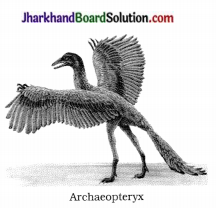
Answer:
Archaeopteryx fossil indicates a connecting link between reptiles and birds. Skeleton of Archaeopteryx was similar to reptiles and it has wings like birds.
Question 4.
Everyone should have knowledge about his / her blood group as well as the blood group of family members. There are four blood group A, B, AB and O.
You consult your family doctor and get more knowledge about blood group.
Questions :
- How is the knowledge of blood grouping essential?
- Whether the blood group of an individual is a hereditary character or an acquired character?
- Whether the son inherits blood group from his father and the daughter inherits blood group from her mother?
- Whether the blood group of the offspring is under the influence of both the parents (father and mother)?
- Whether the genes of blood groups have their dominant and recessive expression?
Answer:
- Blood grouping is essential in a case of blood transfusion.
- The blood group of an individual is a hereditary character.
- No
- Yes, the blood group of the offspring is under the influence of both the parents.
- Yes, genes for blood group A and B are ( dominant and for group O is recessive.
[But A and B are equally dominant with each other and hence called co-dominant.]
Practical Skill Based Questions With Answers
Question 1.
You are supplied with two sets of seeds of pea plants. One set is yellow and round seeds with gene constitution YYRr and other set is green s and round seeds with gene constitution yyRR. From both sets of seeds plants are cultivated, Pea plant is self-pollinated but arrange artificial cross between two given plants cultivated from seeds. Which offsprings do you expect? show? with chart.
Answer:
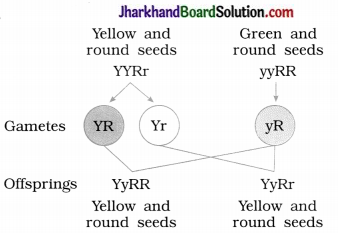
In all offsprings, only dominant trait for seed colour and seed shape are expressed.
i.e., All the plants will have yellow and round seeds.
Question 2.
You observed trait of earlobe whether they are free or attached in four different couples, along with their children.
Questions :
- Couple has all the children with free ear¬lobe even mother has attached earlobe. What do you think about father’s earlobe?
- Couple has children with 1 : 1 ratio for free and attached earlobe. What do you think about their father-mother for this trait?
- In a couple, both father and mother have attached earlobe. What do you think about their children?
- A couple has four children, out of which three have free earlobe and one has attached earlobe. What do you think about their parents?
Answer:
- Father shows free earlobe.
- Any one parent has attached earlobe and other parent has free earlobe with contrasting genes.
- Their children will show attached earlobe.
- Both parent have free earlobe with contrasting genes for earlobe.
Memory Map:
